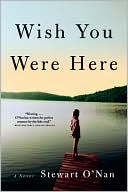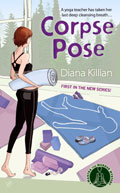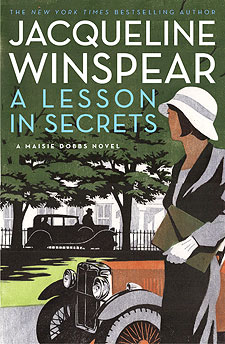"We, as a species, are always looking for cathedrals made of fire, and part of the thrill of reading a great book is the promise of another yet to come, a book that may move us even more deeply, raise us even higher."--Michael Cunningham
Saturday, June 18, 2011
In one sense, Stewart O'Nan's novel Wish You Were Here is Seinfeldian. That is, nothing happens in it. This is not to say, however, that it is funny. In fact, it is mostly sad, or perhaps it would be more precise to say it is wistful, nostalgic, regret-tinged. . .I read it because a friend recommended O'Nan's Emily, Alone, which is its sequel. Wish You Were Here is the story of an extended family's final week at their lakeside vacation home in Chautauqua, New York. Emily, the seventy-something matriarch, has sold the house in the wake of her husband's death.
I can't think of another book that tells the story from the point of view of as many characters as this one does. In addition to Emily, there is her husband's sister, a retired teacher who never married; Emily's two grown children, Ken and Meg; their children, a boy and girl apiece; Ken's wife, Lisa; and the dog, Rufus. O'Nan masterfully moves from the point of view of the widowed Emily, whose children's fates both disappoint and confound her, to those of the two ten-year-old boys, one of whom is reeling from his parents' recent separation and his mother's alcoholism, while the other is driven to petty theft by forces beyond his control. He is equally comfortable describing the inner lives of the teenaged girl cousins, one of whom is tormented by the sudden development of a huge crush on the other, her first-ever attraction to the same sex. The coverage of the characters is spread pretty evenly, with Emily's son Ken perhaps receiving slightly more than the others. Ken is a weak, people-pleasing type of person who is pulled in many directions--his mother is depending on him to fill in for his dead father; his sister has always relied on him and needs him more than ever now that she is facing becoming a single parent and trying to live without alcohol; and his wife is terribly jealous of his closeness with his sister. For his part, Ken would just like time to indulge in his beloved pastime of photography, which is at a kind of crisis point, his mentor having challenged him to try to do it differently, with more spontaneity and less analysis. O'Nan's narration of Ken's thoughts about arranging shots and the descriptions of, for example, the way the light hits them, are cinematic tours de force.
Unfortunately for the characters, it rains continuously for the first half of the week, confining them to the house and keeping them from getting away from the family members they want to avoid. As I said, very little "happens" in the usual sense of the word in this book. The story is more about the conversations that various pairs of characters have about life's momentous events, the things that are said and unsaid and the ways in which loved ones do and do not react exactly as one knows they will. There is a bit of drama around the question of whether Emily will go through with the sale of the house after it emerges that neither her children nor her sister-in-law want her to, and she herself can barely endure the idea that this is their last time there.
Even when it is not describing one of Ken's potential photos, O'Nan's writing in this book is extremely precise in terms of detail, reminding me of Jane Austen's quote about working on a two-inch-wide bit of ivory with a very fine brush. Once or twice I felt almost claustrophobic and thought of not finishing it--this is a thick book, longer than O'Nan's other novels. At the same time, though, when I wasn't reading it I wanted to get back to the lake house to find out how the very small dramas would continue to unfold. And I do want to find out what more will be revealed in Emily, Alone.
Sunday, June 12, 2011
While traveling this spring, I visited one of the many Borders that are, alas, going out of business. The only good news in that situation is the tremendously great buys available as they reach the end of the line. Among the few mysteries left on the shelves was one with a yoga theme, by Diana Killian. It wasn’t the first in the series, so I had to procure that one as an e-book. Corpse Pose was a rather lighter mystery than I usually read, as themed series tend to be, but it was perfectly suited for what I needed at the time, just a bit of a diversion while waiting for airplanes and during lonely moments in hotels and at the occasional solo restaurant dinner. Happily, Killian has another series featuring a scholar of English literature. High Rhymes and Misdemeanors is the first one of those, and judging from the first few chapters, these are also very light entertainments, but they are also pleasingly literate.
Also on that trip I read the eighth Maisie Dobbs mystery, A Lesson in Secrets, by Jacqueline Winspear. I can hardly believe there have already been eight entries in this series, and even more amazing is that they are of uniformly high quality, in terms of both the mystery plot and the character development of the protagonist and those around her. Here’s an illustrative passage from the latest book:
“Sandra was in a sort of limbo, where a past with meaning and promise was gone, and the future as yet held nothing she truly wanted. It was a feeling that demanded to be controlled; otherwise it would wreak havoc in the soul, a sense of angry pointlessness. Hadn’t that been why Maisie herself leaned on her work to bring a meaning that would ground her days? Her relationship with James, the intimacy of connection, was a spark that caught fire—could it all be gone now that she doubted him? Priscilla was right—and wrong. Yes, she controlled her feelings, keeping the dragon at bay with a carefully self-chaperoned life, a protected heart. But Priscilla made letting go sound like a simple task, as easy as a yacht slipping away from the harbor with the wind in its sails. Yet there was always a rock upon which to run aground, and Maisie knew it was her habit to keep a keen eye out for the rocks.”
Susan Hill continues to be one of my favorites among mystery writers. The Shadows in the Street, her fifth Simon Serailler mystery, is the best to date, and that is saying a lot! As is true of many thrillers, the personality and life of the detective are as compelling as the murder mystery, but Hill gives us not just Serailler’s life but that of his immediate family—his sister and her children, his father—and following them from book to book is part of the joy of reading this series.
Subscribe to:
Comments (Atom)



